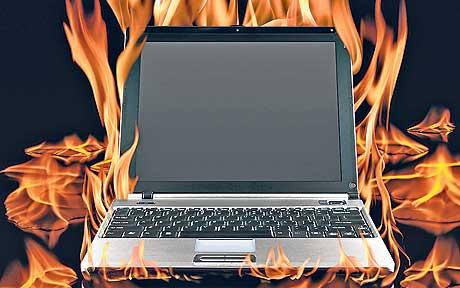Unlike desktops, laptops have a higher chance of overheating due to poor air circulation. This is because the in-built components used to make the laptop are closely packed together leaving no space for adequate circulation. In some cases, this gets so bad that you can’t even place the laptop on your laps. If you want to know the causes, the dangers and the solution to overheating, you ought to read this article.

What Should I Know on Laptop Overheating?
What Are the Signs of Laptop Overheating?
There is a difference between a hot and overheating laptop. Laptops normally produce a lot of heat, but how much is too much?
Below are some of the signs of a laptop that is overheating:
A constantly running fan which is making loud and abnormal noises
Your laptop begins to struggle on performing some specific tasks, for example, when you are trying to access a website, run a game, and watch a video
Popping up of strange error messages on the screen. E.g. “Warning, the system is overheating!”
Dwindling lines on your screen ( this indicates that your video card has overheated)
System freezing. i.e., hanging of programs such as games and videos
Sudden shutting down of the laptop while you are using it
Dangers of Laptop Overheating
An overheating laptop can cause damage to your body. The heat emanating from the laptop can actually be a burn hazard. In fact, Sony recalled more than 500,000 VAIO laptops worldwide due to burning hazard caused by overheating.
Using a laptop at extreme temperatures may damage the hardware components such as video card, the central processing unit, the micro-chips, mother board, hard drives, and memory modules.
Overheating reduces the lifetime of your computer.
An overheating laptop can be a fire danger.
How Do I Check the Temperature of My Laptop?
Ever wondered how you could check the temperature of your laptop? There are free programs that you can use to monitor your laptop’s temperature. Some of these programs can manually or automatically regulate your laptop’s fan speed, for optimum performance. You can download the monitoring program from the internet. Good examples of fan monitors include SpeedFan and RealTemp. These programs are safe and widely used. Furthermore, the programs are easy to use and free to install. You can adjust the program of your choice to suit your needs after installation.
How Do I Stop My Laptop From Overheating?
Work in a Cool Environment
Like human beings, computers operate best in well ventilated areas. They operate optimally at temperatures of 70 °F or lower. In most cases, this is the actual temperature in a normal room or at your work place.
Give Your Laptop a Break
When you realize that your computer is becoming unusually hot, you should save your task for another time and shut down your computer for an hour to let it cool down.
When you’re running heavy software applications like games or photo and video editing suites, your laptop might get unusually hot. Make sure to switch the machine off every now and then. This will give it time to cool off.
Change Your Power Settings
If the power settings for your laptop are set up in such a way that it uses maximum power to run every task, you should adjust it to “Power saver”. This is because the “High Performance” setting puts a strain on the laptop making it get hot faster. If you need to do intensive work like playing graphic intensive games, you can always switch back to the “high performance “setting. To change this settings, go to Control Panel and select Power Options. Here you will be able to change the power plan in use.
Make Sure the Vents Are Not Blocked
Avoid using your laptop on a bed, on a blanket or even a soft board. Soft materials will block the vents and entrap heat within the machine. This goes for your power adapter too. The worst part about this is that you might not even be aware that the laptop is heating up. This could easily damage the laptop or even cause a fire.
Use a Cooling Pad
If your laptop has issues with cooling, you might want to invest in a cooling pad. A cooling pad is an accessory that boosts the flow of air around the laptop. Cooling pads are easily portable and convenient. Choosing one can be tricky as you can’t quite tell whether the pad will work for you from its appearance. Having more fans doesn’t necessarily mean you will have more airflow. This is why it is important to check out the reviews before making a purchase. Make sure to pick one that fits the size of your laptop. Make sure to pick one that fits your budget. Getting an expensive one doesn’t guarantee that it work better. Usually, a decent one will set you back anywhere between $20 and $40.
Clean Your Laptop Often
Debris and dust accumulated over time contribute a great deal to the overheating problems in laptops. You should make time to clean your laptop once in a while. You will need to open up your laptop to do this. You will need a small pinned screw driver to do this. It is worth noting that this might void your warranty if you do it for yourself. If you do not want to void your warranty you’re better off seeking the help of the manufacturer. Get in touch with customer support for a quote.
Check out the video below for step by step tutorial on cleaning your laptop.

View All Comments /Add Comment